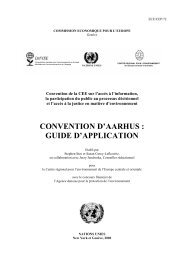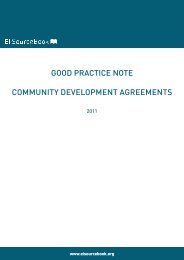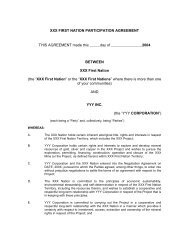Sharing Mining Benefits in Developing Countries - World Bank
Sharing Mining Benefits in Developing Countries - World Bank
Sharing Mining Benefits in Developing Countries - World Bank
You also want an ePaper? Increase the reach of your titles
YUMPU automatically turns print PDFs into web optimized ePapers that Google loves.
• Community participation <strong>in</strong> governance—from no participationthrough to advisory committees and boards that <strong>in</strong>clude communityrepresentatives.• Influence of m<strong>in</strong><strong>in</strong>g company—mov<strong>in</strong>g from full ownership and controlby the m<strong>in</strong><strong>in</strong>g company through to complete <strong>in</strong>dependence from thecompany.• Influence of government—from m<strong>in</strong>imal governmental <strong>in</strong>fluence overthe FTF’s activities through to a legal requirement to establish an FTFand control over the nature and location of development activities.There is no standard approach to m<strong>in</strong><strong>in</strong>g FTFs—experience aroundthe world is varied and difficult to compare. Nevertheless, one criticalcondition for success is evident: adaptation to the local context. Adaptationis presented <strong>in</strong> three dist<strong>in</strong>ct components: complexity, context, and<strong>in</strong>tegration. The complexity of the FTF should be proportionate with thefund<strong>in</strong>g and capacity of the operat<strong>in</strong>g environment. The context needs tobe well understood through extensive social assessment <strong>in</strong> order to appropriatelydef<strong>in</strong>e the vision, beneficiaries, and projects to be supportedby the FTF. Wrapp<strong>in</strong>g this together is the <strong>in</strong>tegration of the FTF with localand regional development plans. Brief case studies that illustrate the <strong>in</strong>terplayof these components appear <strong>in</strong> Chapter 4 of this publication.In addition to present<strong>in</strong>g conditions for success, the case studies highlightthree pr<strong>in</strong>ciples of lead<strong>in</strong>g practice for m<strong>in</strong><strong>in</strong>g FTFs. Those pr<strong>in</strong>ciplescan be expressed as follows:• Higher levels of stakeholder participation are likely to lead to moregrounded, susta<strong>in</strong>able development activities <strong>in</strong> a region, therebyjustify<strong>in</strong>g the additional time and resources that greater participationrequires.• Attention to the detail of governance structures and appropriatemanagement of adm<strong>in</strong>istrative responsibilities can greatly <strong>in</strong>crease theperformance of an FTF and the likelihood that it will attract externalf<strong>in</strong>anc<strong>in</strong>g.• Plann<strong>in</strong>g for the susta<strong>in</strong>ability of an FTF, whether by endow<strong>in</strong>g fundsor expand<strong>in</strong>g stakeholder participation <strong>in</strong> the governance structure,improves the likelihood of deliver<strong>in</strong>g long-term benefits from m<strong>in</strong><strong>in</strong>gprojects <strong>in</strong> develop<strong>in</strong>g countries.2 <strong>Shar<strong>in</strong>g</strong> <strong>M<strong>in</strong><strong>in</strong>g</strong> <strong>Benefits</strong> <strong>in</strong> Develop<strong>in</strong>g <strong>Countries</strong>










